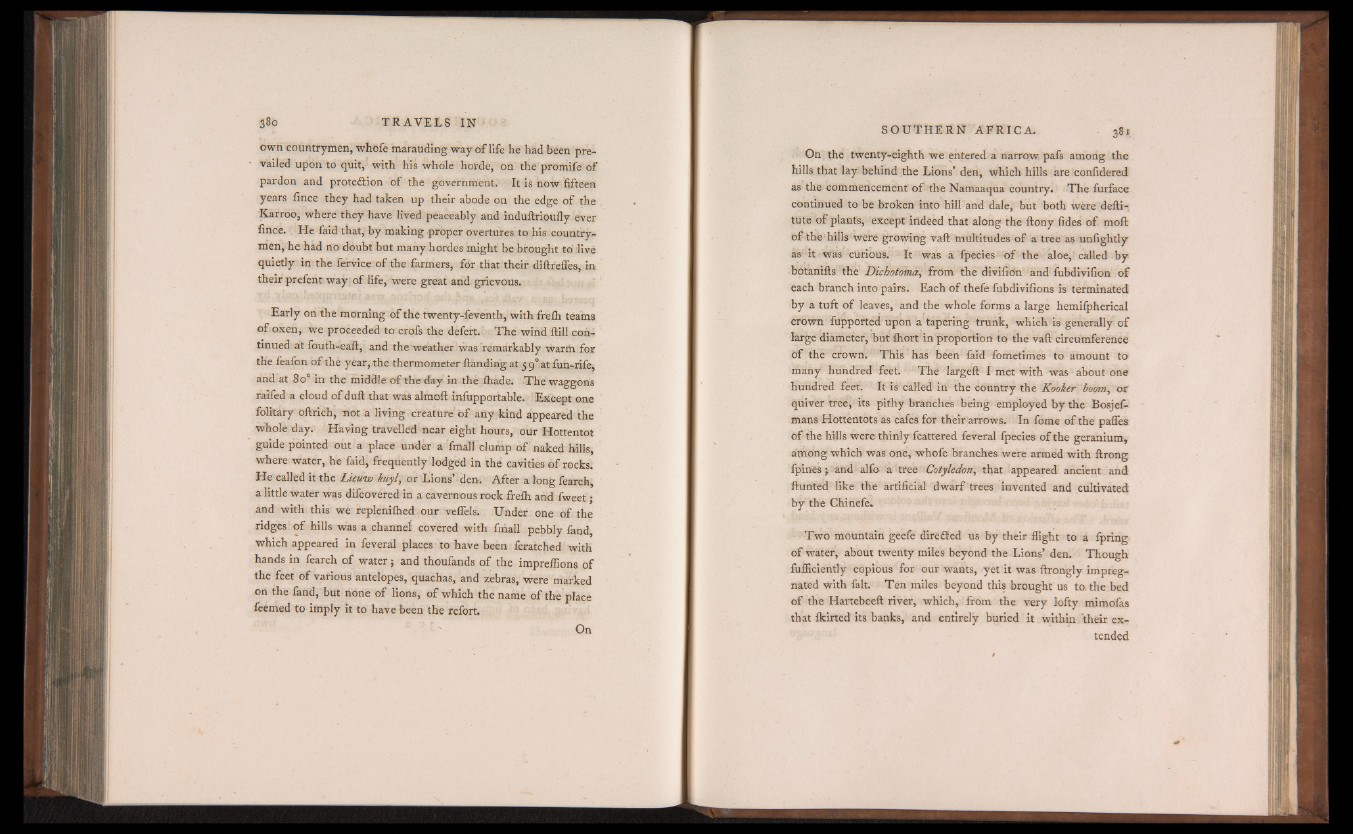
own countrymen, whofe marauding way of life he had been prevailed
upon to quit, with his whole horde, on the promife of
pardon and prote&ion of the government. It is now fifteen
years fince they had taken up their abode on the edge of the
Karroo, where they have lived peaceably and induflrioufly ever
fince. He faid that, by making proper overtures to his countrymen,
he had no doubt but many hordes might be brought to live
quietly in the fervice of the farmers, for that their diflrefles, in
their prefent way of life, were great and grievous.
Early on the morning of the twenty-feventh, with frelh teams
o f oxen, we proceeded to crofs the defert. The wind Hill continued
at fouth-eaft, and the weather was remarkably warm for
the feafon of the year, the thermometer Handing at 3 9° at fun-rife,
and at 80 in the middle of the day in the fliade. The waggons
raifed a cloud of dull that was almoll infupportable. Except one
folitary oftrich, not a living creature o f any kind appeared the
whole day. Having travelled near eight hours, our Hottentot
guide pointed out a place under a fmall clump of naked hills,
where water, he faid, frequently lodged in the cavities of rocks.
He called it the Lieuw kuyl, or Lions’ den. After a long fearch,
a little water was difcovered in a cavernous rock frelh and fweet;
and with this we replenilhed our vefiels. Under one of the
ridges of hills was a channel covered with fmall pebbly fand,
which appeared in feveral places to have been fcratched with
hands in fearch of water; and thoufands o f the impreflions of
the feet o f various antelopes, quachas, and zebras, were marked
on the fand, but none o f lions, of which the name of the place
feemed to imply it to have been the refort.
On
On the twenty-eighth we entered a narrow pafs among the
hills that lay behind the Lions’ den, which hills are confidered
as the commencement o f the Namaaqua country. The furface
continued to be broken into hill and dale, but both were defli-
tute of plants, except indeed that along the llony fides of moll
of the hills were growing vail multitudes o f a tree as unfightly
as it was curious. It was a fpecies of the aloe, called by
botanifis the Dichotoma, from the divifidn and fubdivifion of
each branch into pairs. Each of thefe fubdivifions is terminated
by a tuft of leaves, and the whole forms a large hemifpherical
crown fupported upon a tapering trunk, which is generally of
large diameter, but fliort in proportion to the vaft circumference
of the crown. This has been faid fometimes to amount to
many hundred feet. The largeit I met with was about one
hundred feet. It is called in the country the Kooker boom, or
quiver tree, its pithy branches being employed by the Bosjef-
mans Hottentots as cafes for their arrows. In fome of the pafles
o f the hills were thinly fcattered feveral fpecies o f the geranium,
among which was one, whofe branches were armed with itrong
fpines} and alfo a tree Cotyledon, that appeared ancient and
Hunted like the artificial dwarf trees invented and cultivated
by the Chinefe.
Two mountain geefe direfted us by their flight to a fpring
of water, about twenty miles beyond the Lions’ den. Though
fufficiently copious for our wants, yet it was flrongly impregnated
with fait. Ten miles beyond this brought us to the bed
of the Hartebeefi river, which, from the very lofty mimofas
that ikirted its banks, and entirely buried it within their extended